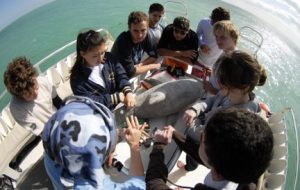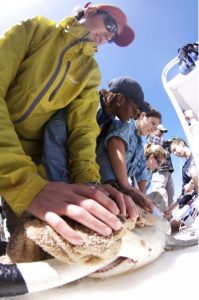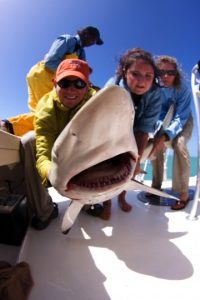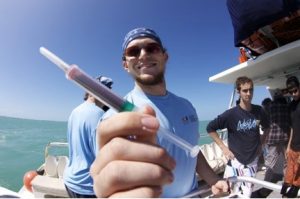Amazing day of shark tagging 3/14/10
3/14/10
We were wary about how the conditions would be due to those of the day prior. Nonetheless, I made my way down with 11 students from Palmer Trinity School to meet Dr. Neil Hammerschlag, Joe Romeiro from 333 Productions, and the rest of the shark team interns. We were also accompanied by another VIP guest, Jillian Morris, Executive Director & Education Coordinator for Oceanic Allstars. Jillian acts as a photographer, videographer, researcher and writer to promote the conservation of sharks and other threatened wildlife. Jillian and director Duncan Brake, produced a video on making Bimini Sands the first shark free marina in the Bahamas. For more information on what Jillian and Duncan do, go to www.oceanicallstars.com.
Upon our arrival, we were faced with calm conditions, so without delay we set out for the day. Before departure, Dr. Neil Hammerschlag discussed with the students the importance of the work that was being done and how it will be used towards the protection and conservation of sharks and their surrounding ecosystems.
After the drumlines were set, while we waited for the lines to soak, the students reviewed the techniques of the workup and jobs were assigned. Instead of the entire group being briefed by the team, the experienced students went through the procedures and equipment, while I stood aside and listened in. The students tend to come back to the program even after graduating because of the knowledge and experience they gain, as well as the impact they feel in contributing to the conservation of sharks.

Miss Leann teaching the class of Palmer Trinity on how to properly tag and measure a shark. (click to enlarge)
When the time arrives to check the lines everyone’s energy builds. Each line is checked and rebaited if there is nothing on it. This gave us 20 chances to catch sharks. It was not as busy as yesterday with the Nurse sharks, but we still managed to catch 3. Two of which were 225 cm in total length (TL). Once again, Joe Romeiro was our in water volunteer, which made the work up much easier and less stressful for the shark.
When drumlines are brought up tangled with monofilament, we all had an idea of what species would be on the end. By the end of the trip we were excited and privileged to work up 2 mature and possibly pregnant female Blacktips of at least 150 cm TL. After working up the sharks Jillian took the time to explain the importance of gathering their data on shark reproduction. She expressed that finding out more about mating and birthing behavior of sharks is crucial to their survival; the areas they mate and pup need to be protected. In reference to protection and policy she told them that, “Fishing seasons need to be regulated, so that breeding animals are not being targeted and removed from the stock. Data collected on these trips will hopefully help put legislation in place.”
We managed to collect data from one other species today, a blacknose shark (female), who only measured to 105 cm TL.
Amongst the drumline sets we also put out and collect fish traps, in order to gather data as to what types of fish are in the area and compare their numbers with that of the sharks in the area. This serves as great educational experience for the students to witness many species in the area. Most of the students have been out on a boat and/or been fishing, so I used this time to test their knowledge and identification skills. In addition to the commercially important species that we collect data and take samples from, today we gathered a spotted moray eel and a sea urchin. The urchin is a fascinating invertebrate species for the students to hold and take a close look at; most assume it is poisonous or dangerous.
Everyone seemed excited that we were catching sharks, but deep down we all wanted a Hammerhead. The day prior we had one on the line, but it got loose after dragging the drumline for almost 1 nautical mile. So, we were all crossing our fingers and sending out the hammer vibes today, but seemed to have no luck, as we were running out of chances. Drumlines were being brought up empty and we were packing up. In the end it was a successful day, between the video footage, still photos, educational moments, hands-on experience, and collection of data from 6 sharks, including 3 species.
On the ride back Jillian noted, after her first experience of what the RJ Dunlap Shark Program that, “Every student on the boat left with a huge smile and a better understanding of the ocean. It was always amazing to see the science world connecting to the average person, especially kids. Changes need to be made and younger generations will be asked to fight for the oceans. Making a connection to these animals at an early age is vital to changing perceptions. Although not every student that goes through the program may become a marine biologist they will hopefully at least think about their choices and influence their parents. South Florida has a large fishing industry as well as hundreds of seafood restaurants. These kids can be apart of smart seafood decisions and the fight to protect sharks in these waters.” Thank you to Jillian and everyone else who participates in some way or another. My students, as well as myself, leave the trips with a feeling of satisfaction that we are indeed doing our part and that one person can make a difference.
By: Leann Winn
(Shark Program Intern and Marine Science Teacher)








Leave a Reply
Want to join the discussion?Feel free to contribute!